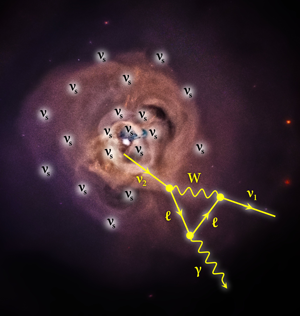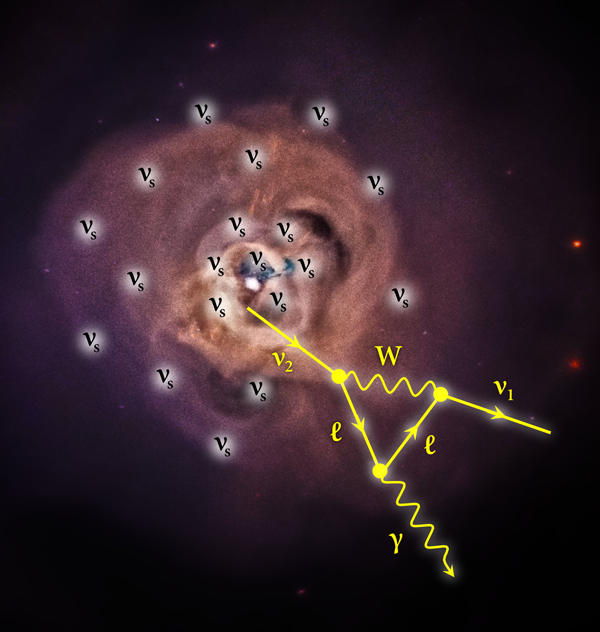X-Ray Line May Have Dark Matter Origin
Dark matter dominates the gravitational interactions that lead to the formation of galaxies as well as the large-scale structure of our Universe. Many sets of cosmological data show that dark matter is approximately 85% of the matter in the Universe. For over eight decades, however, astronomers and physicists have searched unsuccessfully for signatures of dark matter interactions with normal matter. In two recent papers, x-ray astrophysicists have identified a weak—yet statistically significant—line in observations of astronomical structures that harbor large masses of dark matter [1,2]. The fluxes of the detected lines are consistent with the measured dark matter mass within the field of view and could be due to dark matter decay processes [3] that are predicted to be observable in certain dark matter models [4,5].
The Chandra X-ray Observatory and XMM-Newton are satellite telescopes that were both launched in 1999. Shortly after their first science results were released, it was shown that these x-ray astronomy missions could provide a test of certain dark matter theories through observations of galaxies and clusters of galaxies. In particular, dark matter particles with mass in the kilo-electron-volt (keV) mass range could decay into x-ray photons with keV energy [3]. The leading particle dark matter candidate for this x-ray signature is a sterile neutrino. A sterile neutrino is a hypothetical particle that has no weak interaction. It interacts solely with normal matter through gravity, but it can couple to standard neutrinos through oscillations (similar to what happens with solar neutrinos). Oscillations occur because the sterile neutrino νs does not have a definite mass—it is a mixture of different neutrino mass states ( ν1, ν2, etc.). However, in models where the sterile neutrino is a major component to the dark matter, this neutrino mixing is dominated by one state, i.e., νs≈ν2. This mass state can decay through a weak process into a photon and a lighter mass neutrino ν1 (see Fig. 1).
Since the decay is of a nonrelativistic massive particle into a massless photon and relatively massless light neutrino, the decay produces a line spectrum in the x ray. The loop decay is very slow, with decay lifetimes of order 1021 years. However, a cluster of galaxies, like that of the Perseus cluster, has about 1014 solar masses worth of dark matter, which would correspond to more than 1077 dark matter particles of keV mass scale. If this model is correct, then at any given second, one would expect about 1048 sterile neutrinos decaying per second inside the Perseus cluster. Because of the large “sample size” in this and other celestial objects, x-ray telescopes such as Chandra and XMM-Newton have great sensitivity to very slowly decaying dark matter models. However, up until recently, they had not detected any lines and could therefore only set limits on these sorts of sterile neutrino models.
Now, two teams have found evidence of an x-ray line at a consistent energy of approximately 3.5 keV. The line is present in five independent data sets and is proportional to the dark matter mass in the field of view, which may indicate its connection to dark matter decay. Alexey Boyarsky and colleagues [2] found the line in XMM-Newton observations toward the Andromeda galaxy (M 31) and the Perseus cluster, with a combined statistical significance of 4.4σ—meaning that the probability that the line is real rather than some chance fluctuation is greater than 99.999%. To increase sensitivity, Esra Bulbul and colleagues [1] combined XMM-Newton observations of dozens of clusters and found evidence of the same line with a significance of 4– 5σ. They also saw the line at lower significance in observations of the Perseus cluster taken by Chandra. Previous searches had looked for lines in this energy range, but they didn’t have enough sensitivity [6].
To interpret this new line as coming from dark matter, one has to rule out other astrophysical sources that might be the origin. Galaxy clusters harbor a large quantity of hot, thermally emitting x-ray plasma, with abundant atomic transitions emitting x-ray lines. However, the emissivity of the transitions is well studied, and consistent multitemperature models of the cluster observations cannot reproduce the flux observed in the 3.5-keV line. In addition, the line is seen in Andromeda, a single galaxy that does not harbor gas hot enough to produce any lines at such energies [1,2]. Dark matter can potentially produce this x-ray emission—as sterile neutrino models have shown. Moreover, the line is brighter for objects with greater dark matter mass, which is what one would expect if dark matter is the origin.
A definitive test of the dark matter interpretation of the unidentified 3.5-keV line may come from future experiments. Bulbul et al. [1] describe one key test that could be performed by the Astro-H X-ray Telescope, due to be launched in 2015. Astro-H has sufficient energy resolution to resolve the shape of the x-ray line and therefore could tell if the width of the line is relatively broad, which would be consistent with the expected Doppler broadening of dark matter particles orbiting around the center of mass. In contrast, if the line turned out to be narrower in shape, that would suggest the emission is due to a normal atomic transition that is thermally broadened through collisions. Boyarsky et al. [2] describe another test: with increased exposure one could verify whether the line weakens toward the edges of a cluster or a galaxy in a way that matches the predicted dark matter density profile of these objects.
If the line is conclusively shown to be due to dark matter, the implications are of course profound, with a large component of our Universe finally being unmasked. More attention would turn to the models that predict the line. Of particular interest is whether the dark matter producing the line is indeed all of the dark matter, since a sterile neutrino of the so-called Dodelson-Widrow [4] type can produce the signal while making up only about 15% of the total dark matter in the Universe. By contrast, a sterile neutrino of the Shi-Fuller [5] type can account for all of the dark matter. Interestingly, in the latter case, the model’s parameters may alleviate issues in galaxy formation at small scales [7]. Other types of dark matter could also produce the signal, including axionlike particles [8]. Therefore, independent laboratory tests would be needed to verify the existence of a sterile neutrino of the right mass. Although sterile neutrinos are considered in certain reactor experiments studying neutrino oscillations [9], the mass scale in this case (around 1 eV) is far too small to be directly related to dark matter neutrinos. However, there could be a detectable signature of a keV-scale sterile neutrino in nuclear beta decay experiments, where the spectrum of electrons from beta decay have a steplike “kink” in their energy distribution due to some energy being in the rest mass of the sterile state [10].
This research is published in Physical Review Letters and The Astrophysical Journal.
References
- E. Bulbul, M. Markevitch, A. Foster, R. K. Smith, M. Loewenstein, and S.W. Randall, “Detection of an Unidentified Emission Line in the Stacked X-Ray Spectrum of Galaxy Clusters,” Astrophys. J. 789, 13 (2014)
- A. Boyarsky, O. Ruchayskiy, D. Iakubovskyi, and J. Franse, “Unidentified Line in X-Ray Spectra of the Andromeda Galaxy and Perseus Galaxy Cluster,” Phys. Rev. Lett. 113, 251301 (2014)
- K. Abazajian, G. M. Fuller, and W. H. Tucker, “Direct Detection of Warm Dark Matter in the X-Ray,” Astrophys. J. 562, 593 (2001)
- S. Dodelson and L. M. Widrow, “Sterile Neutrinos as Dark Matter,” Phys. Rev. Lett. 72, 17 (1994)
- X. Shi and G. M. Fuller, “New Dark Matter Candidate: Nonthermal Sterile Neutrinos,” Phys. Rev. Lett. 82, 2832 (1999)
- S. Horiuchi, P. J. Humphrey, J. Oñorbe, K. N. Abazajian, M. Kaplinghat, and S. Garrison-Kimmel, “Sterile Neutrino Dark Matter Bounds from Galaxies of the Local Group,” Phys. Rev. D 89, 025017 (2014)
- K. Abazajian, “Resonantly Produced 7 keV Sterile Neutrino Dark Matter Models and the Properties of Milky Way Satellites,” Phys. Rev. Lett. 112, 161303 (2014)
- T. Higaki, K. S. Jeong, and F. Takahashi, “7 keV Sterile Neutrino Dark Matter from Split Flavor Mechanism,” Phys. Lett. B 733, 25 (2014)
- F. P. An et al. (Daya Bay Collaboration), “Search for a Light Sterile Neutrino at Daya Bay,” Phys. Rev. Lett. 113, 141802 (2014)
- C. Kraus, A. Singer, K. Valerius, and C. Weinheimer, “Limit on Sterile Neutrino Contribution from the Mainz Neutrino Mass Experiment,” Eur. Phys. J. C 73, 2323 (2013)





